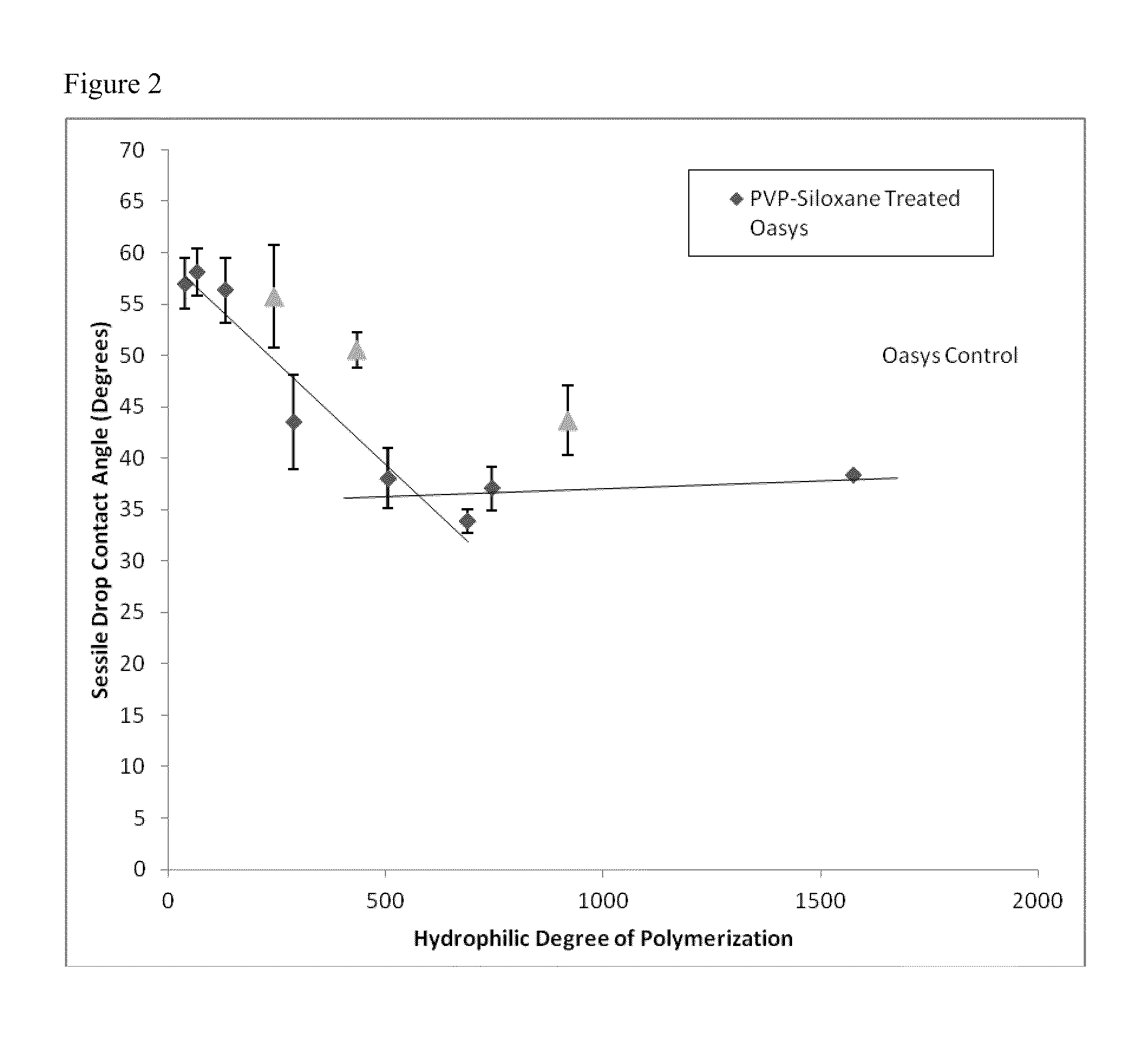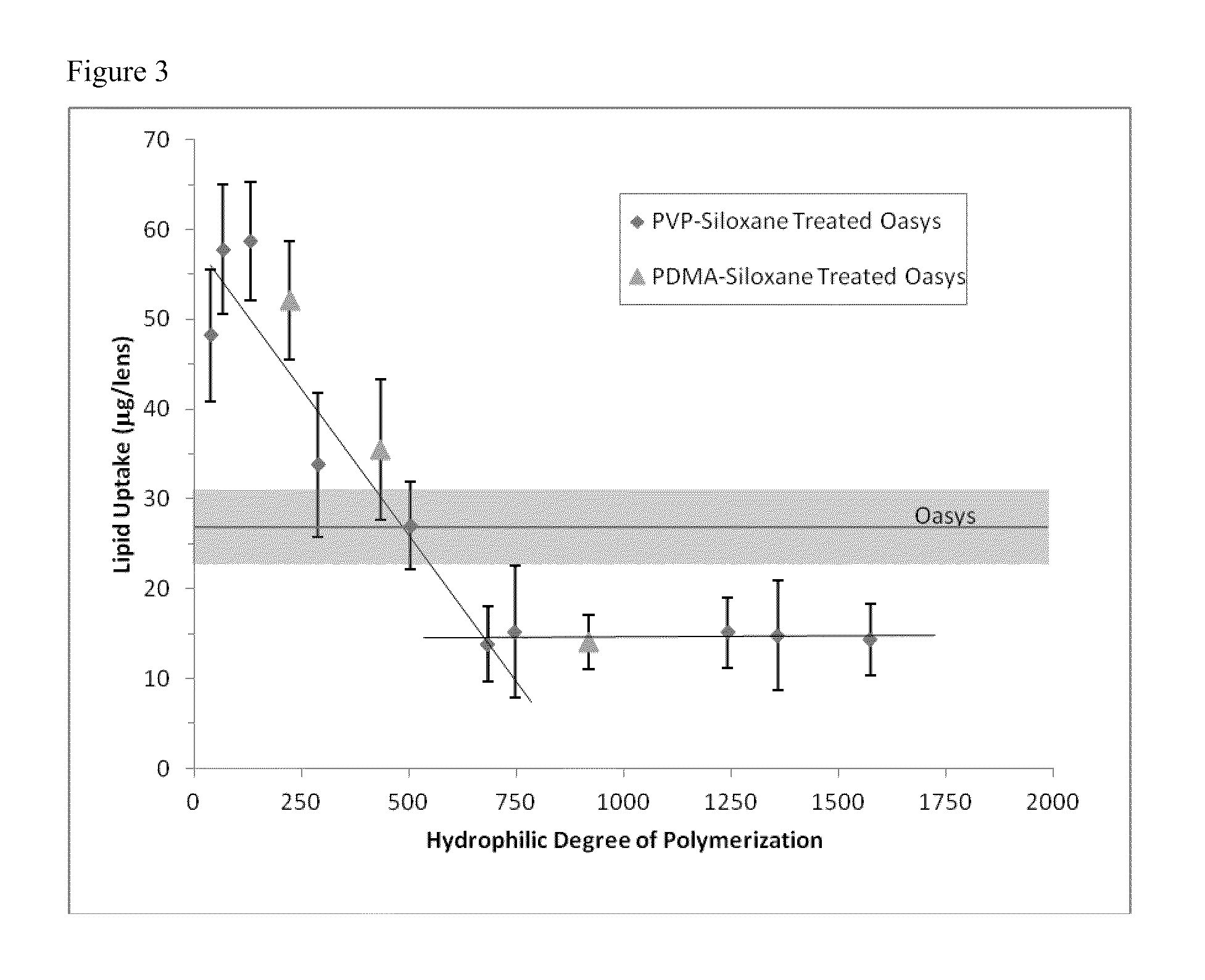Non-reactive, hydrophilic polymers having terminal siloxanes and methods for making and using the same
a technology of hydrophilic polymers and terminal siloxanes, which is applied in the field of hydrophilic polymers having terminal siloxanes, can solve the problems of silicone hydrogels that are not widely used, and exhibit undesirable high contact angles and protein uptak
- Summary
- Abstract
- Description
- Claims
- Application Information
AI Technical Summary
Benefits of technology
Problems solved by technology
Method used
Image
Examples
preparation 1
Hydrosilylation of Allyl Alcohol to nBPDMS
[0223]In a 3 neck round-bottom flask under N2 was added nBPDMS-H (73 g, 0.18 moles, PTG lot# 1708682.001) and allyl alcohol (48 g, 0.83 moles, Fluka lot# 127884154306205). The temperature of the mixture was reduced to 0° C. with an ice bath and 500 microL of Karlstedt's Catalyst (Aldrich 01231) containing 2 wt % platinum in xylene. The ice bath was removed after 5 minutes and the mixture was allowed to reach room temperature. An exotherm was observed and the temperature reached a maximum of 64° C. in a few minutes. The reaction mixture was then cooled in a water bath and left to react for an additional 48 hours. The residual allyl alcohol was removed via roto-evaporation under reduced pressure. The oily liquid was filtered through a small silica plug to recover / remove the platinum catalyst.
preparation 2
Synthesis of 3-(n-butyltetramethylsiloxydimethylsilyl)propyl 4-((ethoxycarbonothioylthio)methyl)benzoate (SBX)
[0224]To a 100 mL round-bottom flask was added 4.71 g (10.0 mMoles) nBSP, 3.0 g (10.5 mMoles) BBB, 1.27 g (10.0 mMoles) Li2CO3, and 20 mL CH3CN. The solution was stirred at room-temperature for 20 hours and subsequently filtered. The clear filtrate was then further reacted with 1.65 g (10 mMoles) of potassium O-ethyl xanthogenate (KX) for 3 hours until a reddish-orange solution was obtained. Toward the end of the reaction, a solid precipitate (KBr) was formed at the bottom of the flask. The mixture was transferred to a reparatory funnel and water and hexanes were added to extract water-soluble impurities. The aqueous phase was removed and washed twice with fresh hexane before discarding. All three hexane phases were combined and dried over anhydrous Na2SO4. The resulting solution was filtered and reduced to a reddish-brown oily liquid via rotary evaporation. The compound str...
preparation 3
Synthesis of PVP-Based Non-Reactive Polysiloxane Terminated Hydrophilic Polymer NRPTHP in the Presence of SBX
[0225]A polymerization solution was prepared with a [NVP]:[SBX] ratio of 300:1 and an [SBX]:[Irgacure-819] ratio of 5:1. Generally, the solution was prepared by adding 50 g distilled NVP to a 100 mL amber jar. Next, 1.063 g of SBX and 125 mg Irgacure-819 were added to the monomer and stirred to ensure homogeneity. The amber jar containing the final polymerization solution was sealed with a rubber septum and purged for 30 minutes with N2 to remove O2 from the solution. Finally, the sealed jar was placed in an N2 glove-box for storage overnight.
[0226]The polymerization solution was cured under an N2 atmosphere with 4 standard Phillips TL 20 W / 03 RS bulbs at intensity of 2.0 mW / cm2 for 3 hours. Prior to curing, the polymerization solution was poured into a crystallization dish, which was then placed on a reflective glass surface. The reaction scheme is shown below in Reaction Sc...
PUM
| Property | Measurement | Unit |
|---|---|---|
| temperature | aaaaa | aaaaa |
| contact angles | aaaaa | aaaaa |
| polydispersity | aaaaa | aaaaa |
Abstract
Description
Claims
Application Information
 Login to View More
Login to View More - R&D
- Intellectual Property
- Life Sciences
- Materials
- Tech Scout
- Unparalleled Data Quality
- Higher Quality Content
- 60% Fewer Hallucinations
Browse by: Latest US Patents, China's latest patents, Technical Efficacy Thesaurus, Application Domain, Technology Topic, Popular Technical Reports.
© 2025 PatSnap. All rights reserved.Legal|Privacy policy|Modern Slavery Act Transparency Statement|Sitemap|About US| Contact US: help@patsnap.com



